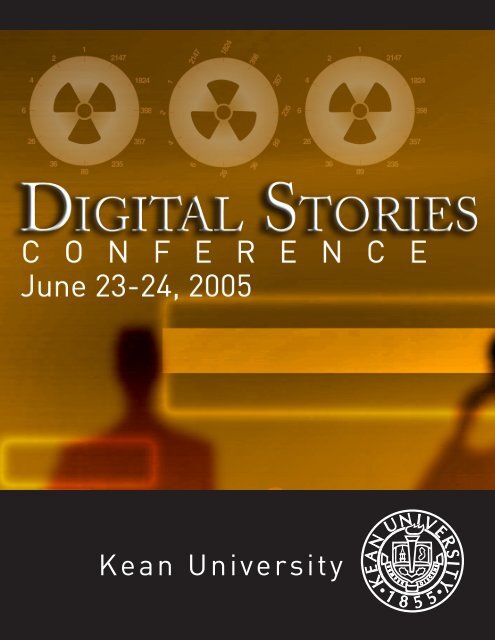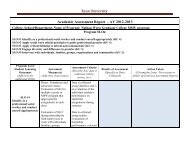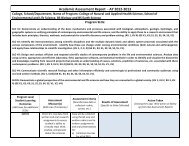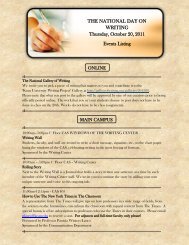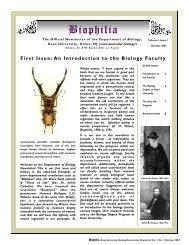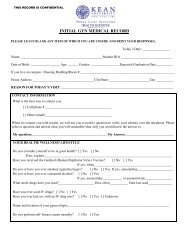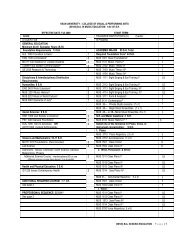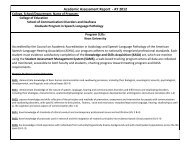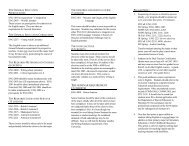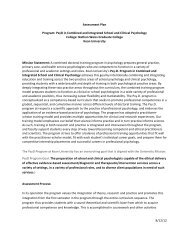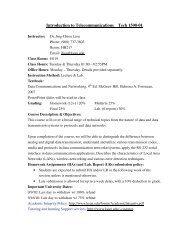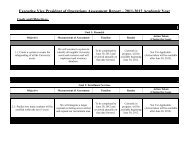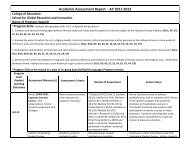print conference brochure - Kean University
print conference brochure - Kean University
print conference brochure - Kean University
Create successful ePaper yourself
Turn your PDF publications into a flip-book with our unique Google optimized e-Paper software.
<strong>Kean</strong> <strong>University</strong>
Thursday, June 23, 2005<br />
8:00-9:00 Registration/ Continental Breakfast Downs Hall<br />
9:00-9:10 Welcome Dawood Farahi, Ph.D., President, <strong>Kean</strong> <strong>University</strong><br />
9:10-9:30 Opening Remarks Michael Searson, Conference Coordinator<br />
9:30-11:00 Panel of Experts: An Overview of Digital Stories Downs Hall<br />
Helen Barrett, International Society for Technology in Education, Assessment Project<br />
Peggy Benton, San Francisco State <strong>University</strong><br />
Joe Lambert, Center for Digital Storytelling<br />
Rob Schadt, Boston <strong>University</strong> School of Public Health<br />
Lalitha Vasudevan, Teacher's College, Columbia <strong>University</strong><br />
11:00-11:15 Break<br />
11:15-12:00 Panel Discussion/Audience Q&A Downs Hall<br />
12:00-1:15 Lunch Downs Hall<br />
1:15-2:45 Panelists’ Breakout Session I (Choose One) CAS Bldg<br />
Digital Storytelling in e-Portfolios for Reflection and Deep Learning<br />
Helen Barrett<br />
CAS 250<br />
The ancient art of storytelling can be a powerful tool for deep learning<br />
and reflection; add today’s multimedia technology and you have a highly<br />
motivating project-based learning activity as well as a powerful artifact in<br />
an electronic portfolio. This presentation will focus on the role of reflection<br />
in electronic portfolios and tools for scaffolding reflection: blogging<br />
and digital storytelling. After a brief overview of the literature on reflection<br />
and learning (Schon, Dewey, Moon), some new perspectives will be<br />
shared on storytelling as reflection on experience to improve learning<br />
(McDrury & Alterio), and on the role of reflection in brain-based learning<br />
(Zull). This presentation will provide some of the pedagogical and theoretical<br />
justification for integrating digital storytelling into the curriculum.<br />
Personal and Creative Digital Storytelling<br />
Joe Lambert<br />
CAS 452<br />
Considered by many the “true” Center for Digital Storytelling, CDS has<br />
set the agenda as a model for training and advocacy in the field of digital<br />
storytelling. The Center professes that all people have stories about<br />
the events, individuals and places in their lives. And CDS is renown for<br />
its “Seven Elements of Digital Storytelling,” which serve as a template<br />
for many other digital storytelling models. This presentation will offer<br />
an overview on the CDS perspective, including the central role of the<br />
script in digital storytelling.<br />
Tell it Your Way<br />
Peggy Benton<br />
CAS 251<br />
Digital storytellers bring rich sources of digital media together to tell a<br />
story in a way that has much more impact and meaning than any one<br />
modality alone. The typical method is to combine digital stills from<br />
scans or digital cameras with music and narrative in a video editing<br />
program and the resulting “story” output is a short movie with a personal<br />
focus. The digital story can told on virtually any topic and may be<br />
a personal story, a documentary, a digital history, digital poetry a digital<br />
album or even digital plays. Still, there are many other ways to tell<br />
a story that suit your skill level and story metaphor. Participants in this<br />
workshop will learn:<br />
1. Easy ways of planning and developing the story. This includes designing,<br />
assembling, sequencing, and formatting their resulting project to<br />
suit their unique needs and abilities.<br />
2. In addition to Movies, stories can be told as animations, books,<br />
graphical novels and slideshows. These will be demonstrated along<br />
with several simple and effective graphic special effects.<br />
Using Digital Story Techniques to Teach the Woburn Case Study<br />
Rob Schadt<br />
CAS 453<br />
In this presentation we will demonstrate an instructional CD-ROM,<br />
Investigating Community Environmental Health Problems, and<br />
describe how it is used to teach public health students in a Masters<br />
level course in Environmental Health. The program is designed as a<br />
resource for both students and members of community groups interested<br />
in the various lessons that were learned in a well-known case.<br />
The CD-ROM was produced to help users determine the environmental<br />
health of a community, particularly as it relates to the presence of hazardous<br />
chemicals. The CD-ROM relies heavily on the experiences of citizens<br />
and public health professionals working in the community of<br />
Woburn, Massachusetts around the contamination episode publicized<br />
in the book and movie "A Civil Action."<br />
The session will also discuss the use of the traditional case method and<br />
a classroom strategy called “structured controversy” which is enhanced<br />
through the use of multimedia CD-ROM technology. Through the disc we<br />
tell the Woburn story through audio and video segments taken from<br />
local cable documentaries and expert panels, as well as documents,<br />
photographs and other media used in or produced in connection with the<br />
trial. When combined with the structured controversy class activity, students<br />
experience the Woburn story directly by "walking a mile in another<br />
person's moccasins," understanding another point of view about the<br />
meaning of a toxic contamination problem for a community.<br />
“Youth-full” Representations in the New Digital Landscape<br />
Lalitha Vasudevan<br />
CAS 455<br />
In our evolving digital culture we are experiencing a visual turn where<br />
the image is no longer subordinate to the word; images are everywhere<br />
and speak volumes. What are the images, then, that make claims about<br />
urban youth? Whose images, stories, and claims count? And where are<br />
the youth? This presentation explores what happened when a group of<br />
boys were involved in a multimedia storytelling project outside the<br />
walls of school. Through their intentional engagement with various<br />
technologies and discursive practices, the boys produced texts and performed<br />
literate identities that challenged dominant scripts that circulate<br />
about their lives. The possibilities for new representational spaces<br />
that technologies present will also be discussed.<br />
Digital Storytelling 101<br />
<strong>Kean</strong> <strong>University</strong>’s PT3 Team<br />
CAS 247<br />
Although not designed to be a complete “how-to” on the creation of digital<br />
stories, this presentation will offer a general overview on the tools<br />
and techniques needed to create digital stories. Necessary hardware<br />
and software (with examples from both Mac and PC platforms) will be<br />
presented. The importance of planning and integration of the major<br />
elements, e.g., images, audio, and scripts, will be discussed. Examples<br />
of digital story techniques will be displayed.
2:45-3:00 Break<br />
3:00-4:30 Panelists’ Breakout Sessions II (Choose One) *Same as above CAS Bldg<br />
4:30-6:00 Conference Reception Downs Hall<br />
Day 2<br />
Friday, June 24, 2005<br />
8:00-9:00 Registration/ Continental Breakfast Downs Hall<br />
9:00-9:15 Day 2 Kickoff<br />
9:15-10:15 Keynote Speech Downs Hall<br />
“Digital Stories: An Intersection between the Arts and Education?”<br />
Joe Lambert, Center for Digital Storytelling<br />
10:15-10:30 Break<br />
10:30-11:15 "And now for something special...."<br />
Kimiko Ryokai, Massachusetts Institute of Technology<br />
11:15-11:30 Break<br />
11:30-12:15 Concurrent Sessions (Choose One) CAS Bldg.<br />
Beyond Words: The Craftsmanship of Digital Stories (Part I)<br />
Bernajean Porter, Digitales, Colorado<br />
CAS 236<br />
Storytellers are now able to “envision” information using digital tools to<br />
make sense of, evaluate and share their deep understanding of historic,<br />
social and political topics. As we practice the craftsmanship of designing<br />
information through mixing colors, images, symbols, voice tones, music,<br />
sound and artful pacing, we are also striving to crystallize our perspectives<br />
into memorable digital stories that reveal meaning and understanding<br />
out of the data and complexity in our lives. This session will provide<br />
awareness and first steps of the craftsmanship of digital stories. (NOTE:<br />
This is a two-part session, with part two offered at 1:30 p.m.)<br />
Helping Families Preserve and Celebrate Their Favorite Stories<br />
Dan Barrett, Digital Family Stories, Seattle<br />
CAS 237<br />
The family records preceding those of my great-grandfather have not<br />
yet been discovered. It is sad that we cannot go back and put the names,<br />
dates, places and events together. Sadder still is that the stories about<br />
how they lived and what made them unique are forever lost. Through<br />
digital storytelling we can preserve our family stories and pass on our<br />
legacies to future generations. We will share several examples of family<br />
stories and the steps for creating, preserving and celebrating them.<br />
Student Reflections on International Experiences:<br />
Finding Their Voices<br />
Alexandra Wood, Sarian Samura, Joel Thomas, Nathalia Giraldo and Kate<br />
Boye, <strong>Kean</strong> <strong>University</strong> Center for International Studies Staff & Students<br />
CAS 238<br />
Millennials are the first generation to grow up immersed in a digital<br />
technology environment. This generation demonstrates an inherent<br />
appreciation of multiculturalism and an awareness of globalism. Such<br />
traits enable them to succeed in the study of international affairs, particularly<br />
thriving in international experiential learning situations. <strong>Kean</strong><br />
<strong>University</strong>’s Institute for Foreign Service and Diplomacy employs digital<br />
stories as a reflective tool to combine the students’ familiarity with<br />
technology and their international experiences.<br />
Preschool Children and the Computer… Telling Their Stories and<br />
Creating Portfolios<br />
Laura Melanson, <strong>Kean</strong> <strong>University</strong> Child Care Center<br />
CAS 247<br />
Participants will be introduced to the art of creating digital stories with<br />
young children. Through the use of programs such as iPhoto, iMovie,<br />
and iDVD, participants will also view examples of digital portfolios created<br />
by <strong>Kean</strong> <strong>University</strong> Child Care Center students. Reactions by parents<br />
to their children’s work will also be discussed.<br />
Using Digital Stories as Evidence of Learning Through Reflections of<br />
Field Experiences<br />
Jo Hoffman & Rodrigo Oliveira, <strong>Kean</strong> <strong>University</strong>, Department of Early<br />
Childhood Education<br />
CAS 250<br />
This presentation is the making of a digital story as a collaborative project<br />
between an early childhood student teacher and his supervisor. The<br />
digital story ultimately serves as a powerful visual artifact with reflection.<br />
The presentation will demonstrate how digital stories can be<br />
effective in demonstrating achievement of college of education learning<br />
outcomes.<br />
Memories in Motion<br />
Deana Miele, <strong>Kean</strong> <strong>University</strong> Graduate Student<br />
CAS 251<br />
Every day, we are creating stories through our interactions with others<br />
and our typical events. These moments, which are often overlooked and<br />
forgotten, can be the foundation of an exciting story. As the creation of<br />
my digital story has taught me, the surprising twists of everyday life can<br />
lead to unexpected results. It is time to focus on these events and interactions<br />
to discover what stories can surface.<br />
Remnants of Revolution: The War for Independence in Union County<br />
Mark Lender, Ann Phau, Eileen Eordanidis, <strong>Kean</strong> <strong>University</strong><br />
Department of History Faculty and Students<br />
CAS 252<br />
This short "mini-documentary" looks at what is left of the historic<br />
structures and landscapes of the Revolutionary period in Union County,<br />
New Jersey. Its objective is to stimulate an interest in regional history<br />
as the key to explaining the larger issues of the Revolution to students—often<br />
students with little understanding of or cultural ties to the<br />
events of 1775-83.<br />
Don’t Be Dan! – A Model for Introducing Digital Storytelling<br />
Dina Rosen, Rob Zupko, and Gregg Festa, Montclair <strong>University</strong>, NJ<br />
CAS 341<br />
Now that digital media have become easier and more affordable to use,<br />
their potential in the classroom can be more fully realized. Participants
will experience one fast-track method for introducing the concepts and<br />
skills needed to create a digital story. Strategies for developing crossuniversity<br />
collaborations as well as an institutionalized support system<br />
for digital storytelling will be discussed.<br />
Multi-Dimensional StoryTelling<br />
Lester Ray, Apple Computers, Inc.<br />
CAS 355<br />
Digital Stories can come in many different flavors, from the creation of<br />
simple audio offerings, to visual poetry, to complex multi-media messaging.<br />
Using these digital tools, teachers have discovered a new way to<br />
bring excitement into their classrooms and help students make meaningful<br />
connections to research topics. There is an art and science to their<br />
development. Come explore some of the tools that can be used in their<br />
creation.<br />
Program Stories: Creating Digital Stories to Highlight Program<br />
Content or Activities<br />
Kristine Mirrer and Cathleen Londino, <strong>Kean</strong> <strong>University</strong>, Department of<br />
Broadcast Media & Film<br />
CAS 357<br />
Faculty can create program related stories or assign stories as projects<br />
to explain, introduce, or highlight content. Digital storytelling skills<br />
combine research, writing, and production and are applicable to any<br />
discipline. Examples, techniques and discussion will be provided.<br />
A Multimedia Approach to Bookmaking<br />
Yvonne W. Bouknight, Reading Specialist, Glen Ridge Public School , NJ<br />
CAS 358<br />
The presenter will discuss the process of making digital stories.<br />
Information will be given on using Digital Storytelling as vehicle to develop<br />
narrative writing. Participants will be shown a model that explains the<br />
process of creating a digital story and view stories produced by fifth grade<br />
students.<br />
"It Looks Like a Good Idea... Now What???"<br />
Brian Lohse, Meg Sass, Victoria Patterson, Allamuchy Township<br />
School District, NJ<br />
CAS 359<br />
Digital Storytelling workshop from the teachers' point of view. We will<br />
review planning the project, introducing it to the students, writing rough<br />
drafts, and working around class time to complete the project. Samples<br />
of class work, from drafts to finished product, will be available.<br />
12:15-1:30 Lunch “Grill and View” Downs Hall & Area<br />
Join us for a BBQ and viewing of selected digital stories<br />
1:30-2:15 Concurrent Sessions Two (Choose One) CAS Bldg.<br />
Beyond Words: The Craftsmanship of Digital Stories (Part II)<br />
Bernajean Porter, Digitales, Colorado<br />
CAS 236<br />
Storytellers are now able to “envision” information using digital tools<br />
to make sense of, evaluate and share their deep understanding of historic,<br />
social and political topics. As we practice the craftsmanship of<br />
designing information through mixing colors, images, symbols, voice<br />
tones, music, sound and artful pacing, we are also striving to crystallize<br />
our perspectives into memorable digital stories that reveal meaning<br />
and understanding out of the data and complexity in our lives. This<br />
session will provide awareness and first steps of the craftsmanship of<br />
digital stories. (NOTE: This is a two-part session, with part one offered<br />
at 11:30 a.m.)<br />
Helping Families Preserve and Celebrate Their Favorite Stories<br />
Dan Barrett, Digital Family Stories, Seattle<br />
CAS 237<br />
The family records preceding those of my great-grandfather have not<br />
yet been discovered. It is sad that we cannot go back and put the names,<br />
dates, places and events together. Sadder still is that the stories about<br />
how they lived and what made them unique are forever lost. Through<br />
digital storytelling we can preserve our family stories and pass on our<br />
legacies to future generations. We will share several examples of family<br />
stories and the steps for creating, preserving and celebrating them.<br />
Student Reflections on International Experiences:<br />
Finding Their Voices<br />
Alexander Wood, Sarian Samura, Joel Thomas, Nathalia Giraldo, and<br />
Kate Boye, <strong>Kean</strong> <strong>University</strong> Staff & Students<br />
CAS 238<br />
Millennials are the first generation to grow up immersed in a digital<br />
technology environment. This generation demonstrates an inherent<br />
appreciation of multiculturalism and an awareness of globalism. Such<br />
traits enable them to succeed in the study of international affairs, particularly<br />
thriving in international experiential learning situations. <strong>Kean</strong><br />
<strong>University</strong>’s Institute for Foreign Service and Diplomacy employs digital<br />
stories as a reflective tool to combine the students’ familiarity with<br />
technology and their international experiences<br />
Preschool Children and the Computer… Telling Their Stories and<br />
Creating Portfolios<br />
Laura Melanson, <strong>Kean</strong> <strong>University</strong> Child Care Center<br />
CAS 247<br />
Participants will be introduced to the art of creating digital stories with<br />
young children. Through the use of programs such as iPhoto, iMovie,<br />
and iDVD, participants will also view examples of digital portfolios created<br />
by <strong>Kean</strong> <strong>University</strong> Child Care Center students. Reactions by parents<br />
to their children’s work will also be discussed.<br />
Using Digital Stories as Evidence of Learning Through Reflections of<br />
Field Experiences<br />
Jo Hoffman & Rodrigo Oliveira, <strong>Kean</strong> <strong>University</strong>, Department of Early<br />
Childhood Education<br />
CAS 250<br />
This presentation is the making of a digital story as a collaborative project<br />
between an early childhood student teacher and his supervisor. The<br />
digital story ultimately serves as a powerful visual artifact with reflection.<br />
The presentation will demonstrate how digital stories can be effective<br />
in demonstrating achievement of college of education learning outcomes.<br />
Memories in Motion<br />
Deana Miele, <strong>Kean</strong> <strong>University</strong> Graduate Student<br />
CAS 251<br />
Every day, we are creating stories through our interactions with others<br />
and our typical events. These moments, which are often overlooked and<br />
forgotten, can be the foundation of an exciting story. As the creation of<br />
my digital story has taught me, the surprising twists of everyday life can<br />
lead to unexpected results. It is time to focus on these events and interactions<br />
to discover what stories can surface.<br />
Taking it on the Road: Digital Stories from Maricopa Community<br />
Colleges—Study Abroad in Ireland, Australia, and New Zealand<br />
Dale Doubleday, Maricopa Community Colleges, Arizona<br />
CAS 252<br />
For the past two years, Maricopa Community Colleges has offered Digital<br />
Storytelling classes as part of Study Abroad Programs in Ireland,<br />
Australia, and New Zealand. Despite technology challenges and time
constraints, all participating students completed stories of personal<br />
journeys that bridge cultural gaps and broaden horizons. During this<br />
presentation, Dale Doubleday, Art Faculty and Media Arts Program<br />
Director, Phoenix College, will share these digital stories and answer<br />
questions about the experience of teaching Digital Storytelling while<br />
"taking it on the road."<br />
Be a Good Ancestor--Making a Family History for Generations to<br />
Come<br />
David Beardsley, Trinity Television & New Media, NY<br />
CAS 341<br />
This workshop covers practical ways of combining video interviews,<br />
home movies, audio recording, photos, written records and text into one<br />
interactive document. Topics include hardware and software selection,<br />
the production process, interviewing techniques, and distribution.<br />
Examples will be shown from actual completed projects.<br />
Multi-Dimensional StoryTelling<br />
Lester Ray, Apple Computers, Inc.<br />
CAS 355<br />
Digital Stories can come in many different flavors, from the creation of<br />
simple audio offerings, to visual poetry, to complex multi-media messaging.<br />
Using these digital tools, teachers have discovered a new way to<br />
bring excitement into their classrooms and help students make meaningful<br />
connections to research topics. There is an art and science to their<br />
development. Come explore some of the tools that can be used in their<br />
creation.<br />
From the Lap to the Laptop: Montessori Reading Lessons<br />
Bob Korngold, Montessori Home, Inc. NY<br />
CAS 357<br />
This workshop will present a demonstration of instructional,<br />
Montessori-based software that children can use at home, to enhance<br />
their classroom experiences of learning to read. It will also address<br />
how Montessori teachers can support parents in the process of combining<br />
class work with at-home work, to enhance their children’s<br />
learning.<br />
The Division of Student Affairs and Storytelling<br />
Judy April, <strong>Kean</strong> <strong>University</strong>, New Jersey Center for Science and<br />
Technology Education<br />
CAS 358<br />
In the GOLD program, self-reflection allows students to find an appreciation<br />
for, and an understanding of, effective leadership practices. The<br />
Student Affairs division incorporates digital storytelling into student<br />
leadership development initiatives such as the Cougar Campaign.<br />
Digital Storytelling enhances student leadership development through<br />
reflection and digital memoirs. This method of reflection encourages<br />
our student leaders to document their experiences on and off campus.<br />
Cougar Care Program<br />
Katrina Boseman, <strong>Kean</strong> <strong>University</strong>, Office of Student Affairs<br />
CAS 358<br />
<strong>Kean</strong> <strong>University</strong> has adopted two cougars - Scout and Sage, that are<br />
housed at Essex County's Turtle Back Zoo. <strong>Kean</strong> was the first New<br />
Jersey College or <strong>University</strong> to formally adopt an animal at the zoo as<br />
its mascot and provide funding for the upkeep of the animals. The <strong>Kean</strong><br />
Cougar Care Program was created to increase awareness of our<br />
Mascots, promote student volunteerism, and foster the <strong>Kean</strong> Cougar<br />
Spirit.<br />
From Digital Photographer to Digital Storyteller<br />
Anne Rudnicki, Houston Endowment LITE Fellow/<strong>University</strong> of<br />
Houston, TX<br />
CAS 359<br />
The LITE fellows, in pursuit of creating meaningful connections with<br />
teachers, students, and schools in the Houston area, have begun<br />
designing and implementing the LITE Works program. The concept is<br />
that the LITE fellows will make themselves available to teachers and<br />
students to help them in developing further their technology skills. This<br />
presentation will provide an overview of the work done by LITE fellows<br />
with Digital Storytelling at the <strong>University</strong> of Houston.<br />
2:15-2:25 Break<br />
2:25-3:10 Concurrent Sessions Three (Choose One) CAS Bldg.<br />
Remnants of Revolution: The War for Independence in Union County<br />
Mark Lender, Ann Phau, Eileen Eordanidis, <strong>Kean</strong> <strong>University</strong><br />
Department of History Faculty and Students<br />
CAS 236<br />
This short "mini-documentary" looks at what is left of the historic<br />
structures and landscapes of the Revolutionary period in Union County,<br />
New Jersey. Its objective is to stimulate an interest in regional history<br />
as the key to explaining the larger issues of the Revolution to students—often<br />
students with little understanding of or cultural ties to the<br />
events of 1775-83.<br />
Advocacy Through Digital Storytelling<br />
Dina Rosen, Montclair <strong>University</strong>, NJ<br />
CAS 237<br />
Digital Storytelling utilizes digital media to assist people in communicating<br />
important, personal stories that can touch the hearts of viewers<br />
and move audiences towards positive action. In this roundtable, participants<br />
will view sample ‘Advocacy Digital Stories’ and discuss the<br />
potential for using digital stories as an advocacy tool. Procedures and<br />
strategies for developing digital stories that provide resources and tools<br />
necessary for audiences to take timely action will be considered.<br />
From Digital Photographer to Digital Storyteller<br />
Anne Rudnicki, Houston Endowment LITE Fellow/<strong>University</strong> of<br />
Houston, TX<br />
CAS 359<br />
The LITE fellows, in pursuit of creating meaningful connections with<br />
teachers, students, and schools in the Houston area, have begun<br />
designing and implementing the LITE Works program. The concept is<br />
that the LITE fellows will make themselves available to teachers and<br />
students to help them in developing further their technology skills. This<br />
presentation will provide an overview of the work done by LITE fellows<br />
with Digital Storytelling at the <strong>University</strong> of Houston.<br />
Program Stories: Creating Digital Stories to Highlight Program<br />
Content or Activities<br />
Kristine Mirrer and Cathleen Londino, <strong>Kean</strong> <strong>University</strong>, Department of<br />
Broadcast Media & Film<br />
CAS 247<br />
Faculty can create program related stories or assign stories as projects<br />
to explain, introduce, or highlight content. Digital storytelling skills combine<br />
research, writing, and production and are applicable to any discipline.<br />
Examples, techniques and discussion will be provided.<br />
A Multimedia Approach to Bookmaking<br />
Yvonne W. Bouknight, Reading Specialist , Glen Ridge Public School, NJ<br />
CAS 250<br />
The presenter will discuss the process of making digital stories.<br />
Information will be given on using Digital Storytelling as vehicle to develop<br />
narrative writing. Participants will be shown a model that explains the<br />
process of creating a digital story and view stories produced by fifth grade<br />
students.
"Have I Got a Project for You!!!”<br />
Barbara Lohse, Allamuchy Township Public School District, NJ<br />
CAS 251<br />
This workshop will be from the perspective of staff development--How<br />
to get teachers interested in trying a digital story project with their students,<br />
planning and setting up the project, the mechanics of project<br />
facilitation, and publishing the project to take home.<br />
Taking it on the Road: Digital Stories from Maricopa Community<br />
Colleges—Study Abroad in Ireland, Australia, and New Zealand<br />
Dale Doubleday, Maricopa Community Colleges, Arizona<br />
CAS 252<br />
For the past two years, Maricopa Community Colleges has offered Digital<br />
Storytelling classes as part of Study Abroad Programs in Ireland,<br />
Australia, and New Zealand. Despite technology challenges and time<br />
constraints, all participating students completed stories of personal<br />
journeys that bridge cultural gaps and broaden horizons. During this<br />
presentation, Dale Doubleday, Art Faculty and Media Arts Program<br />
Director, Phoenix College, will share these digital stories and answer<br />
questions about the experience of teaching Digital Storytelling while<br />
"taking it on the road."<br />
Be a Good Ancestor—Making a Family History for Generations to<br />
Come<br />
David Beardsley, Trinity Television & New Media, Syracuse, NY<br />
CAS 341<br />
This workshop covers practical ways of combining video interviews,<br />
home movies, audio recording, photos, written records and text into one<br />
interactive document. Topics include hardware and software selection,<br />
the production process, interviewing techniques, and distribution.<br />
Examples will be shown from actual completed projects.<br />
Digital Stories as Tools for Literacy Development<br />
Diane H. Tracey, <strong>Kean</strong> <strong>University</strong>, Department of Communication<br />
Sciences<br />
CAS 355<br />
Digital storytelling will be examined through the lens of literacy education.<br />
What literacy skills are strengthened through the creation of digital<br />
stories? Are digital stories a feasible way to build students’ literacy<br />
skills?<br />
From the Lap to the Laptop: Montessori Reading Lessons<br />
Bob Korngold, Montessori Home, Inc. NY<br />
CAS 357<br />
This workshop will present a demonstration of instructional,<br />
Montessori-based software that children can use at home, to enhance<br />
their classroom experiences of learning to read. It will also address<br />
how Montessori teachers can support parents in the process of combining<br />
class work with at-home work, to enhance their children’s<br />
learning.<br />
The Division of Student Affairs and Storytelling<br />
Judy April, <strong>Kean</strong> <strong>University</strong>, New Jersey Center for Science and<br />
Technology Education<br />
CAS 358<br />
In the GOLD program, self-reflection allows students to find an appreciation<br />
for, and an understanding of, effective leadership practices. The<br />
Student Affairs division incorporates digital storytelling into student<br />
leadership development initiatives such as the Cougar Campaign.<br />
Digital Storytelling enhances student leadership development through<br />
reflection and digital memoirs. This method of reflection encourages<br />
our student leaders to document their experiences on and off campus.<br />
Cougar Care Program<br />
Katrina Boseman, <strong>Kean</strong> <strong>University</strong>, Office of Student Affairs<br />
CAS 358<br />
<strong>Kean</strong> <strong>University</strong> has adopted two cougars - Scout and Sage, that are<br />
housed at Essex County's Turtle Back Zoo. <strong>Kean</strong> was the first New<br />
Jersey College or <strong>University</strong> to formally adopt an animal at the zoo as<br />
its mascot and provide funding for the upkeep of the animals. The <strong>Kean</strong><br />
Cougar Care Program was created to increase awareness of our<br />
Mascots, promote student volunteerism, and foster the <strong>Kean</strong> Cougar<br />
Spirit.<br />
3:10-3:20 Break<br />
3:20-4:05 Small Group Discussions: Integrating Digital Stories Downs Hall<br />
4:05-4:30 Closing/Door Prizes Downs Hall
Background Information on Panelists<br />
Helen Barrett just retired from the faculty of the College of Education at the <strong>University</strong> of Alaska Anchorage and is living in the Seattle area. She has<br />
been researching strategies and technologies for electronic portfolios since 1991, publishing a website (http://electronicportfolios.org), an Apple<br />
Learning Interchange exhibit (http://ali.apple.com/ali_sites/ali/exhibits/1000156/), chapters in several books on Electronic Portfolios, and numerous<br />
articles. She was on loan to the International Society for Technology in Education between 2001 and early 2005, working on assessing ISTE’s National<br />
Educational Technology Standards and providing training and technical assistance on electronic portfolios for teacher education programs throughout<br />
the U.S.under a federal PT3 grant. In 2005, Dr. Barrett became the Research Project Director for The REFLECT Initiative, an international research project,<br />
underwritten by TaskStream, to assess the impact of electronic portfolios on student learning, motivation and engagement in secondary schools.<br />
She is currently working on several book projects on electronic portfolios. She is also an Apple Distinguished Educator and a George Lucas Educational<br />
Foundation Faculty Associate.<br />
Peggy Benton is Professor of Instructional Technologies (ITEC) at San Francisco State <strong>University</strong> (SFSU) teaching graduate courses in digital graphics,<br />
visual communication, multimedia, and technology leadership for educators. She directs the development of ITEC masters culminating work as well<br />
as designs and coordinates the courses in technology integration for pre-service teachers. Dr. Benton directed two federal grants for Preparing<br />
Tomorrow’s Teachers to use Technology, (PT3, 1999-2004). Funded by the US Department of Education, her program focusing on infusing technology<br />
in teaching and learning as well as professional development of faculty and pre-credential teachers. She was featured on the national PT3 website<br />
(PT3.org success stories) for educational and creative use of digital video. Her PT3 project web site was also chosen by the US Department of Education<br />
as a model of best practices in user centered design (http://www.sfsu.edu/~teachers/pt3.html). In addition to the PT3 grants, she has had four innovative<br />
educational grants funded by state and federal sources in such areas as distance learning, digital video, multimedia, classroom-integrated professional<br />
development and project based learning. She is enthusiastic about the use of technology in solving problems we face in twenty-first century education.<br />
She has integrated project based learning across the curriculum and developed technology integration demonstration projects with components<br />
such as multimedia, distance learning, digital storytelling, video conferencing, games and immersive 360° imaging, virtual field trips, panoramas,<br />
object movies and online learning communities. She was selected as an Apple Distinguished Educator for 2004 and a George Lucas Education<br />
Foundation Faculty Associate for 2003 and 2004. Dr. Benton has presented at numerous national and international <strong>conference</strong>s and has delivered<br />
keynote speeches on technology leadership. Her research area focuses on applications of visual imagery to improve learning. Dr. Benton works with<br />
such collaborative partners as Apple Computer, Oracle Corporation, Buck Institute for Education, Center for Enhancement of Teaching, the George<br />
Lucas Educational Foundation, CTAP and local school districts. It is in this network of collaborating, innovating, and sharing that she believes we can<br />
create an educational culture promoting active, engaged and meaningful learning that develops real-world solutions.<br />
Joe Lambert is the Founding Director of the Center for Digital Storytelling. Mr. Lambert founded the CDS (formerly the San Francisco Digital Media<br />
Center) in 1994 with Nina Mullen and Dana Atchley as a community arts center for new media and the Internet. Along with Mr. Atchley and Ms. Mullen,<br />
he has developed a unique computer training and arts program, Digital Storytelling. The process grew out of Mr. Lambert's long running collaboration<br />
on Dana Atchley's solo theatrical multimedia work, Next Exit. Digital Storytelling has also been offered in 26 U.S. states and ten countries, assisting in<br />
the completion of more than 5000 video works. During the period, Lambert has led a number of the projects involving media production, publication<br />
and curriculum development. The media projects include management and design of the CDS Website and CD Sampler (1995-2002), production design<br />
for Jon Sanborn's Paul Is Dead and Blue Funk web narratives (1995), Foundry- an experimental website on social issues (1996), the International Digital<br />
Mural Project (1997), On Lok Health Services Training Website (1997), and the California Arts Council's 1998 Conference on Arts and Technology website,<br />
the Managing Information for Rural America CD ROM, and the recent CD ROM for the Kansas City Symphony. His has authored and produced curriculum<br />
in many contexts including the Digital Storytelling Cookbook, the principal manual for the digital storytelling process, and a new text entitled<br />
Digital Storytelling: Capturing Lives, Creating Community.__Mr. Lambert has been active in the Bay Area arts community for the last seventeen years<br />
as an arts activist, producer, administrator, teacher, writer, and director. He was the Executive Director of the People's Theater Coalition from 1984-<br />
86. In 1986, he co-founded Life On The Water, a successful non-profit production company that offered a broad array of programs serving San<br />
Francisco's diverse communities. Mr. Lambert has produced over 500 shows, in the context of theatrical runs, single performances, special events,<br />
citywide festivals, subscription series and <strong>conference</strong>s. Prior to his career in the arts, Mr. Lambert was trained as a community organizer, assisting in<br />
numerous local, statewide and national public policy campaigns on issues of social justice and economic equity.<br />
Rob Schadt is the Educational Technology Manager at the Boston <strong>University</strong> School of Public Health and Director of the Office of Teaching, Learning<br />
and Technology. He is also an instructor in the College of Communications in the Department of Mass Communication, Public Relations and<br />
Advertising. He received his Doctorate in Education from Boston <strong>University</strong>. He has a M.Ed. in Instructional technology and a M.A. in Sociology from<br />
Boston College and a B.A. in Political Science from the SUNY at Cortland. He lives with his wife and two children in Ashland, Massachusetts. He brings<br />
twenty-five years of experience working with faculty in higher education to this newly created position at School of Public Health at Boston <strong>University</strong>.<br />
Previously, he worked for Tufts <strong>University</strong> School of Medicine and New England Medical Center where Schadt was Production Manager for the<br />
Educational Media Center. In addition to his skills as a media producer, he has experience as a faculty consultant regarding distance learning and presentation<br />
design. He received his Doctorate in Education from Boston <strong>University</strong>, and has an M.Ed. and a M.A. in Sociology from Boston College and a<br />
B.A. in Political Science from the SUNY at Cortland.<br />
Lalitha Vasudevan is a Postdoctoral Fellow at Teachers College, Columbia <strong>University</strong> in the Department of Curriculum and Teaching. Her research is<br />
focused on the interrelationships across media/technologies, literacies, youth culture, and urban education. This year she is involved in a new research<br />
project that explores the lives and experiences of youth straddling the justice and education systems in New York City through youth-produced multimedia<br />
stories. She is currently co-editing a volume titled Media, Learning, and Sites of Possibility that critically examines the integration of media/technologies<br />
in teaching/learning spaces with youth. In the fall she will join the faculty of Teachers College as an Assistant Professor of Communication and<br />
Education.<br />
Kimiko Ryokai is a new PhD candidate in the Tangible Media Group at Massachusetts Institute for Technology (MIT). She is currently investigating the<br />
role of tangible interfaces in supporting collaborative storytelling and learning. Ryokai is from Tokyo, and moved to the US to study after graduating<br />
from Komatsugawa high school in Tokyo. She earned her undergraduate degree from SUNY Stony Brook with a double major in Linguistics and<br />
Psychology, and her MS with the Gesture and Narrative Language group at the Media Lab. Outside the Media Lab, Ryokai is in search of good food, cute<br />
little things, and time to practice her violin.
Located in N.J., <strong>Kean</strong> <strong>University</strong> is just minutes away<br />
from Newark Liberty International Airport and<br />
Newark Penn station. It is easily accessible via the<br />
New Jersey Turnpike, the Garden State Parkway, and<br />
routes 1&9, 22 and 78.<br />
With the opening of a NJ Transit train station across<br />
from <strong>Kean</strong>’s campus in 2003, the <strong>University</strong> is now a<br />
30-minute commute to New York City. Conference<br />
participants are welcome to take advantage of <strong>Kean</strong>’s<br />
proximity to NYC to go sightseeing, to dine in worldclass<br />
restaurants, or to take in a Broadway show.<br />
Conference participants can easily take a train to the<br />
historic Ironbound district, home to Newark’s finest<br />
restaurants, as well as to Hoboken, N.J., hometown of<br />
Frank Sinatra and the site of some of the area’s best<br />
dining and nightlife.<br />
DIGITAL STORIES<br />
A CELEBRATION OF LEARNING<br />
PREPARING TOMORROW’S TEACHERS TO USE TECHNOLOGY


